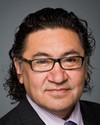Yes.
Evidence of meeting #126 for Natural Resources in the 42nd Parliament, 1st session. (The original version is on Parliament’s site, as are the minutes.) The winning word was crees.
A recording is available from Parliament.
Evidence of meeting #126 for Natural Resources in the 42nd Parliament, 1st session. (The original version is on Parliament’s site, as are the minutes.) The winning word was crees.
A recording is available from Parliament.
Chair and Chief Executive Officer, Inuvialuit Regional Corporation
Secondly, yes, I agree. You've answered the question yourself. We should sit down together and work this out because it isn't giving any comfort to industry itself as well. They've all walked away from their investments to explore within their region. As I pointed out earlier, some of them are sitting on trillions of cubic feet of gas as well as oil. The country is being held at ransom by this process that we have where we allow them to not develop as well.
Conservative

Shannon Stubbs Conservative Lakeland, AB
Those are huge lost opportunities obviously in your community that relate to all of Canada and to the benefit of the future of our country.
Thanks to all of you.
NDP

Romeo Saganash NDP Abitibi—Baie-James—Nunavik—Eeyou, QC
Thank you, Mr. Chair.
Thank you to all of our witnesses this afternoon.
I would like to engage with all of you. Most of you mentioned free, prior and informed consent even qualifying in this as an investment for a project's success, if I heard you correctly.
I tend to agree with that but I want to start with you, Brian. We've worked many years together in the past, in my previous life. You say in paragraph 3 of your presentation that the Cree of Eeyou do not suggest that their experience with energy projects necessarily holds lessons for others.
I beg to differ on that. You mentioned section 22 of the James Bay and Northern Quebec Agreement as being an important chapter in the agreement that contains a recognition of a right to development to the territory for those acting lawfully in the territory. It's been part of the rules of the game in northern Quebec for many years now.
I understand that the Cree, over the years since they first signed the James Bay and Northern Quebec Agreement in 1975, have had over 80 agreements since then.
Would you qualify those 80 agreements that we signed with mining companies, Hydro-Québec, the two governments and so on, as free, prior and informed consent in action?
Director, Federal Relations, Grand Council of the Crees (Eeyou Istchee)
I couldn't call every instance of an agreement with a proponent as being fully consulted by the community, for the community, although we're talking about fairly small communities; and they like to maintain their position in their own territories so that they can work out different formulas with proponents.
One of the challenges that the Grand Council and the Cree Nation Government have is to make sure these agreements are consistent with agreements in other places in the territory, not only so that they're like the others but so that they make the bar, they're within the range of what the Crees have negotiated in the past.
On the big issues, there's been a lot of effort put into people being informed. We've spent a lot of money on it. We've spent a lot of time on it as well. The results are important. We went from the La Grande project, which didn't have any real impact assessment, to the EM1A project, which is a project that includes close to $1 billion worth of dikes being put along the river to maintain the water level at the natural level while at the same time diverting some of the water toward the La Grande project.
You have to take these types of questions one at a time and make sure you understand all the variables.
NDP

Romeo Saganash NDP Abitibi—Baie-James—Nunavik—Eeyou, QC
Thank you.
Chief Louis, you were asked about the meaning of reconciliation in this era of reconciliation. It always reminds me of the Supreme Court decision in 2004 in the Haida Nation case, where the Supreme Court says, talking about reconciliation, that the objective is to reconcile the pre-existing sovereignty of indigenous peoples with the assumed sovereignty of the Crown. These are the words of the Supreme Court; they are not mine.
Would that be a good, fundamental base on which to start reconciliation in this country?
Okanagan Indian Band, Assembly of First Nations
Absolutely, there needs to be some consideration of what the starting point is of that.
If you look at the last 20 years, you see it's been the Supreme Court of Canada that's been providing most of the guidance to government on how consultation and accommodation happen. There have been hard-fought cases by first nations. It's actually cleared the air on a lot of issues.
But now, as we're getting close to this era of consultation and moving on to accommodation. I point to one of the decisions that recently happened out of Clyde River, a very good decision. One of the decisions that came out of there—and I have a quick note on that—is what was described as the Crown failing to inquire into Clyde River's rights and specific impacts on their rivers, and yet focusing on the environmental effects.
Part of reconciliation must be the understanding of what the actual impacts are to an aboriginal right. If you go to any other sector in Canada, you find what's called upon is the development of a socio-economic analysis that actually measures impacts, what the impacts are of imposing a statutory decision or not. That comes out of the Statutory Instruments Act.
But you also look at other mechanisms. There isn't one for first nations that actually looks at what the impacts are of a loss of fisheries. Yet a loss of fisheries is huge to aboriginal peoples. When you look at it, you see there is nothing on the plate, when the guarantee of Canada is to ensure that we have access for our food, social and ceremonial use. If you look at the southern end of the provinces, you find there are very few traditional foods that are actually left upon our plate.
Part of reconciliation must be, can we actually recover those uses? I think reconciliation is, how do we actually determine how we're going to live together in the future? So yes, I do agree with your statement.
David de Burgh Graham Laurentides—Labelle, Lib.
I will use my time wisely. I have two questions. I'll try to get through them quickly, so I hope you can help me with that.
How do we deal with indigenous communities that are divided within themselves and between each other on whatever topic? If there's no consensus, there's no consensus. How do we arrive at a decision?
To build on that, in pre-contact culture, what was the process for arriving at decisions when a community was divided within itself?
I'll ask Chief Louis if he'd like to start.
Okanagan Indian Band, Assembly of First Nations
There are a lot of different processes within the cultures. For us, at a point when there was a disagreement amongst community members, sometimes we would bring in an independent arbiter who could be from a neighbouring nation. It also includes examples of that in the past where disagreements amongst the communities could be resolved through arbitration of an individual or a non-partial....
When you mention this division between the hereditary and what now is under the Indian Act, one of the things that you find is that is some of the problem. In British Columbia you have the Campbell decision that says aboriginal rights are infringed but remain intact. I'm just paraphrasing that. Basically it says that hereditary laws still exist and still have full force. On the other hand, you have this Indian Act that's adopted where it's a vote by a majority.
Laurentides—Labelle, Lib.
Thank you, Chief. I'm enjoying this answer, but I'm already out of time, and I have one quick point that I'd really like to make.
Liberal
Laurentides—Labelle, Lib.
In that case, I'll make my other point, and I'll come back to that. Thank you.
My other point was, when we're dealing with communities that want to be involved in the project and, if there are no institutions already in place to work with, who do you work with and how do you build up the institutions within the communities to work with us?
Okanagan Indian Band, Assembly of First Nations
I think the question is one of having a hereditary system against the elected body, and basically one says yes and the other says no. I think, at a certain point, is there a possibility of arbitration within that cultural context of those individuals within those nations? If not, is there the ability to bring in an outside independent body to reach that? Sometimes you just have to accept that no means no. I think that's where we come to the impasse.
Laurentides—Labelle, Lib.
What about the question of institution building within communities in order to have someone to talk to, not only to talk to but capable of acting on what's decided? If you wanted to do some significant resource extraction in a community that isn't in a position to do it or to work with it, how do we prepare an institution to do that?
Okanagan Indian Band, Assembly of First Nations
I think one of the best ways to achieve that is to look at the Haida, for instance, who developed their community-based constitution that governs how these decisions are made. In that context, I think that probably provides the best opportunity for looking at resolutions that would be considered internal, like the example you gave of the disagreement between the traditional and hereditary. However, that's got to be something that needs to be built, because you look at over 100 years of this practice, and this is the result of that. Now these first nations, including ours, need that time to heal those rifts and bring that back together. Again, in a roundabout way, one of the best ways to achieve that is what the Haida have done through the development of their constitution, which all their members support.
Laurentides—Labelle, Lib.
Mr. Helin, you talk a lot about the divisions in the community and how the decision arrived at on the tanker ban wasn't the one that you wanted.
Per Chief Louis's comments, what's the best process for you for a consultation when there's a significant division in the community?
Mayor, Lax Kw'alaams Band
I think the best process is to get the best information to all members. Dividing them between an elected body and a hereditary body is not a good way to go. I'm elected as a mayor in my position. I also belong to a tribe, so I am a tribal member. In our tribal system, we had chiefs, sub-chiefs and speakers. That has broken down over the years. People are claiming names that they shouldn't be claiming, so there's disarray and confusion.
For me, I don't want to label somebody as a hereditary chief or.... We're all equal, and we should all have the same information, the right information, so we can make an informed decision on any project or proposed issue, keeping in mind that the environment is the most important part of anything that's being proposed.
Director, Federal Relations, Grand Council of the Crees (Eeyou Istchee)
Perhaps I can add something to that.
You have to look at the makeup and the history of a particular group before you can understand how to basically do business with them or work with them. For example, in the Cree case in northern Quebec, we don't have one elder; we have hundreds of elders. They're all responsible for their hunting territories, their trapping territories. All of that has to be built into the way you approach that community.
As well, the Innu on the north shore and the Crees signed an agreement recently on how to settle issues like the one we're talking about today, about how to divide the benefit from any development that occurs in the areas that are disputed.
That's just one of the things going on.
Laurentides—Labelle, Lib.
Okay.
My time is up for real this time, I think, so I'll ask Mr. Smith if he has any last comments on the same question and then I'll call it a day. Thank you.
Chair and Chief Executive Officer, Inuvialuit Regional Corporation
As the second-oldest claim, we have an established process that's been in place for quite a number of years. As well, in terms of overlapping issues, when we were trying to develop the gas within our region we had proposed a pipeline from my area to Alberta. We created the Aboriginal Pipeline Group, which is made up of all of the indigenous groups along that corridor.
That's a good example of how we work together for the mutual benefit of trying to develop the resource. Unfortunately, the price collapsed and fracking started.
Liberal

The Chair Liberal James Maloney
Thank you all very much for coming today. We don't have enough time, as we never do—I'm grateful for your patience in waiting in security—so if there's more information that you feel you wanted to provide us with in your presentation, or you didn't have enough time to answer a question, please free to forward it to us. We'll consider it as part of our report.
Thank you all very much for joining us today. We're very grateful.
The meeting is adjourned.